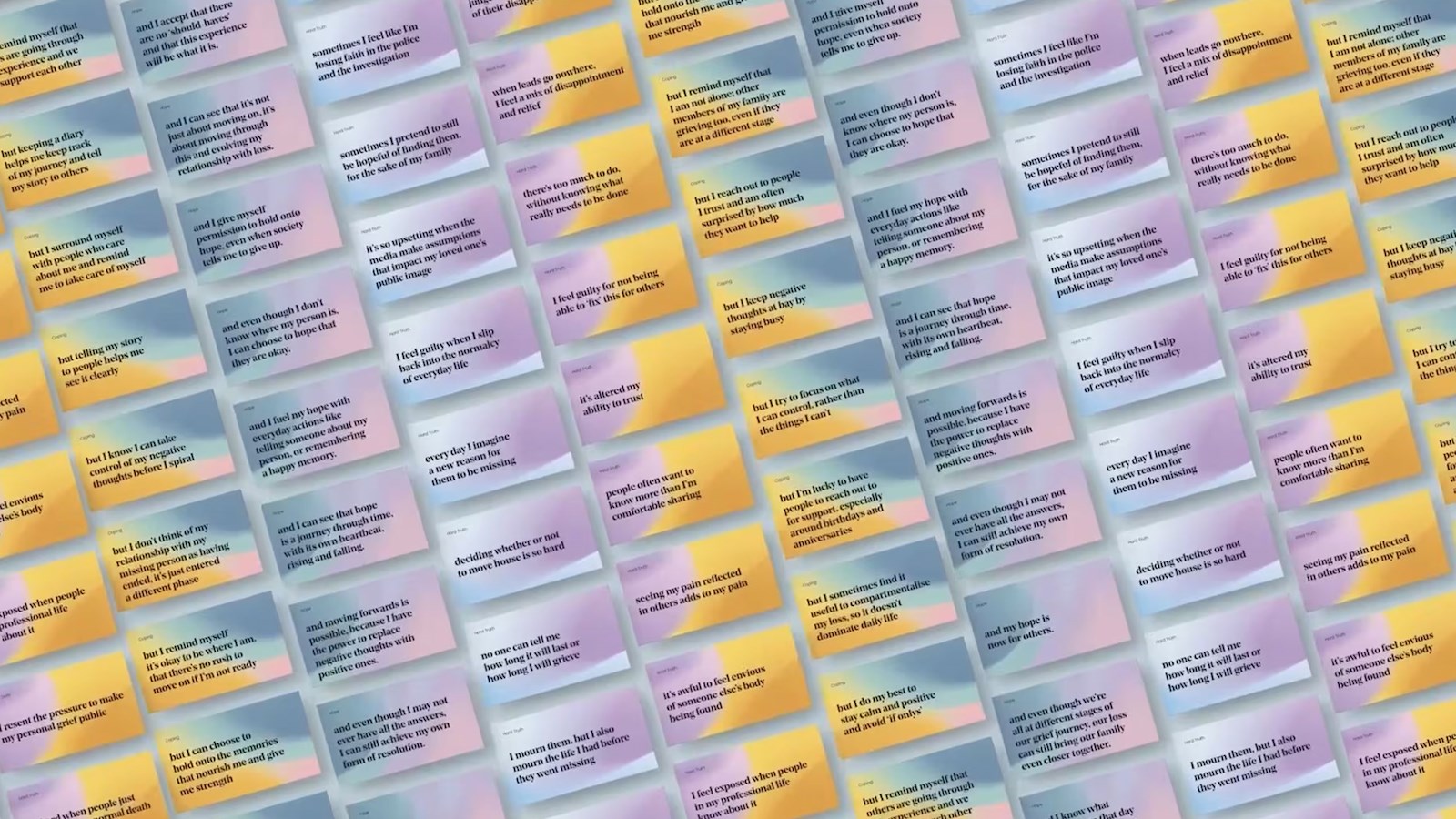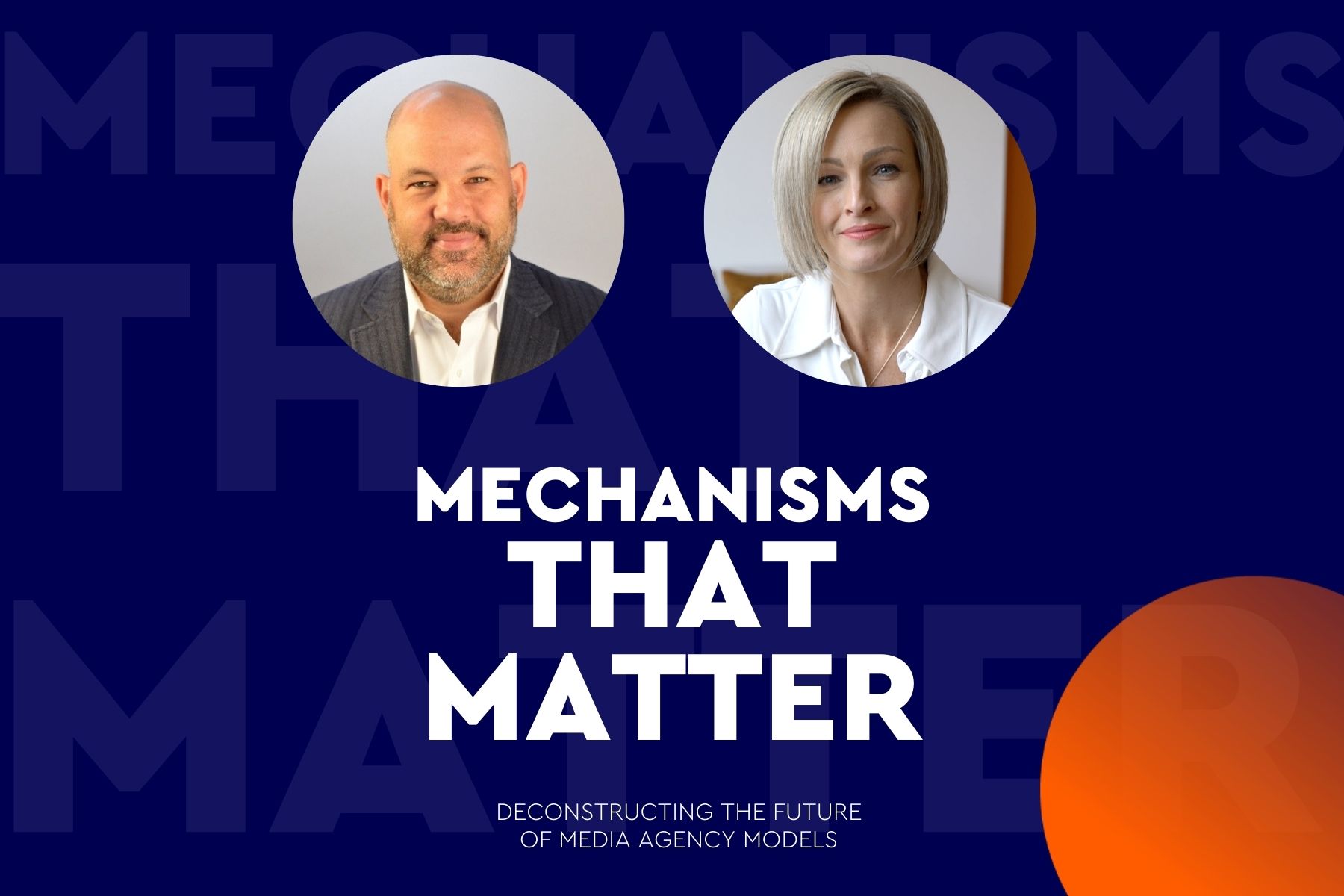
Language as a therapeutic tool
How WPP’s whiteGREY harnessed the power of language to create The Hope Narratives: a world-first therapeutic tool, designed to treat ‘ambiguous loss’
For a small population, we lose a lot of people. Around 145 Australians daily. Numbers like that obscure other parts of the issue. The plight of missing persons is generally framed as a binary ‘lost’ or ‘found’ until it is either ‘case closed’ or we simply move on to another pressing issue. The reverberating heartbreak of those left behind is essentially invisible.
So the challenge stubbornly remains: we (rightly) look for the missing person, but we don’t heal those left behind, the ones suffering from a particularly insidious form of grief called ambiguous loss.
The most traumatic form of grief
Ambiguous loss is the unique form of grief experienced by the loved ones of missing persons, considered by many psychologists to be the most traumatic type of loss. It is so deeply devastating because it evades the most fundamental human need of dealing with loss: closure. It is a daily, even hourly cycle of optimism and despair, ultimately ending in a stalemate of the mind, a fog of confusion and humans are not built like that. We can’t just blindly hope.
Our tension to solve: How can you help someone deal with the most traumatic grief, when there’s no resolution and no-one realises what you are going through?
When you talk to those dealing with ambiguous loss, the hardest part for many is how alone and voiceless they feel due to the lack of familiar language and channels for grief.
Talking. Words. Voices. Ambiguous loss has none. Maybe if we gave it some, it would help sufferers and rally Aussies – who have simply no way to comprehend it – to the cause. We reframed the issue by turning to the voiceless.
We found a need for healing language for the loved ones of missing people to express themselves when the world renders their experiences invisible. Only language could humanise the missing by spotlighting the lives impacted in their absence. In the moments that matter, words count.
But rather than create work ‘about’ the experience of ambiguous loss, we set our sights on doing something much more fundamental, valuable and enduring for sufferers of ambiguous loss. We would create a tool to combat it. If therapy was our end, language would be our means.
The Hope Narratives
The Hope Narratives is a world-first modular language system that enables people impacted by ambiguous loss to tell their stories and navigate their grief by putting the emotional complexity of ambiguous loss into words.
Created in collaboration with world-leading ambiguous loss experts, The Hope Narratives cards combine over 500 collective years of lived experience, from interviews in eight countries, into 145 modular statements, which connect to become over 1.4m possible Hope Narratives.
Honouring lived experience
Workshops and surveys that sourced first-hand accounts were overseen by world-renowned expert in ambiguous loss, Dr Sarah Wayland, and Loren O’Keeffe, MPAN founder and ambiguous loss sufferer. The process involved taking the spoken and written words of participants and distilling these to grammatical components of an overall sentence, while always honouring the participant’s intent. The verbatim quote behind each distilled piece of language is shown on the back of each Hope Narrative card, along with an appropriate identifier for the participant.
A modular system
The system combines three modules: truth, coping behaviour and hope. The modules are designed so that users can find start points, verbalise what they are reluctant to say out loud, find a coping method they often denied themselves, and then find hope in the resolution. It is a peer-to-peer system, eschewing more traditional therapist-to-patient approaches of the past, and a leap forward in innovation for one of the moments that matter most to any human being.
Crafting modularity
Once the language had been distilled, it was tested and adjusted in relation to the matrix of adjacent pieces of language as a result of this to ensure both grammatical and emotional functionality. Each piece of language needed to connect to the next to create both meaning, and healing.
Impact in the moments that matter
The Hope Narratives has earned 22m in reach, over 170 pieces of media coverage, and has generated an 800% increase in searches for ambiguous loss.
World-renowned ambiguous loss expert Dr Sarah Wayland has called The Hope Narratives ‘a revolutionary gift’. Channel Ten News called it a ‘world first therapeutic tool’. It has been covered on the ABC, Channel Nine and YouTube.
It is now a globally recognised therapeutic tool, having been translated into nine languages. Missing persons advocacy and academic groups are implementing the tool, including Missing People (UK), The National Missing Persons Helpline (Ireland), Ontario’s Missing Adults (Canada), Leave a Light On (Australia), The Australian Association of Psychologists, The Australian Clinical Psychology Association, The Royal Australian & New Zealand College of Psychiatrists and The Australian Counselling Association.
This has been a massive shift in how Australians see the issue – from awareness of the missing persons issue in this country, to greater lobbying for increased funding for services to locate missing persons, to ultimately helping those left behind in ways that weren’t possible before.
Credits
Client: MPAN (Missing Persons Advocacy Network)
Founder and CEO: Loren O’Keeffe
Creative Agency: whiteGREY
published on
30 November 2023
Category
More in Communications

Rebranding cancer: how brands heal and hurt
Along with consumer brands, the ‘brand’ of condition or event influences us.

Mechanisms that Matter – Inside WPP | Ford’s revolutionary marketing model
How a process created on the factory floor over 70 years ago has transformed ops for the auto giant

How to build your brand in-game
A new research report from WPP and SuperAwesome

